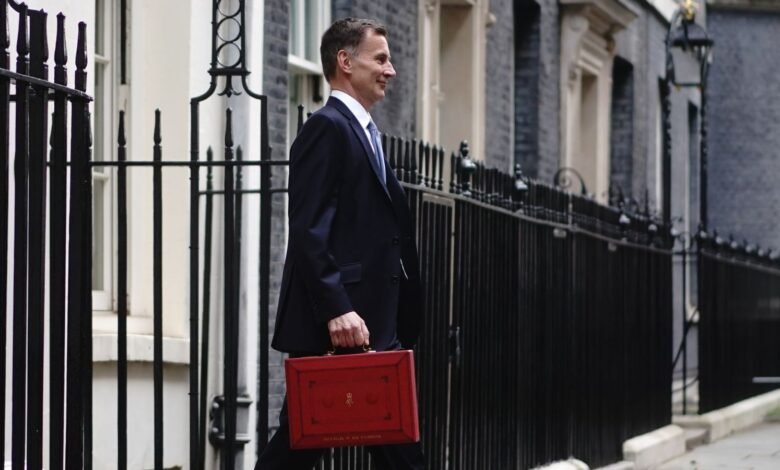How very inaccurate forecasts determine the amount spent on investment or tax cuts in budget | Business News

The £13bn financial “headroom” Chancellor Jeremy Hunt has allowed himself is based on forecasts which have proven to very, very inaccurate in the past. So inaccurate that they’ve been off by the value of more than double the NHS budget or four whole HS2s.
By Ed Conway, Economics and data editor @EdConwaySky
Before we get on to the budget itself – with all its rumoured tax cuts, economic policies and pre-election politicking – let me start with a question.
Every six months, at each budget and autumn statement, the Office for Budget Responsibility (OBR) produces a set of forecasts for how it thinks the economy will do in the coming years.
Money blog: What 2p cut to national insurance means for your take-home pay
Among those forecasts are numbers on where it thinks the national debt – the total amount the state owes to investors – will be five years hence.
So here’s the question: how accurate would you say those forecasts have been in recent years? A few billion pounds out, maybe? A few percentage points here or there?
The answer matters, because rather a lot depends on these very forecasts.
Overshadowing this budget is the fact the government has three fiscal rules, intended to reinforce confidence in its policymaking.
Of them, the most binding is that it needs to get the national debt falling by the end of the forecast horizon (in other words between year four and year five).
Fiscal ‘headroom’
The difference between those two numbers – the national debt (as a percentage of gross domestic product) in 2027/28 and 2028/29 – is what determines the “headroom” the chancellor has against his fiscal rules.
In other words, by the letter of those rules, everything – from how much he plans to spend on investment to how much he can cut taxes – comes back to the difference between those numbers, years four and five of the OBR forecasts.
Jan 2024: What is fiscal headroom?
Right now that “headroom” is £13bn. But national debt figures move about rather a lot, as do GDP figures.
A sudden economic shock can send the debt load soaring higher, as can a rise in interest rates. And forecasting anything five years hence is tremendously difficult.
So these very numbers – the ones upon which everything else depends – are, to put it lightly, quite volatile.
That brings us back to the question we started with – about how accurate those forecasts turned out to be in the past. The answer is: very, very inaccurate.
The average forecasting error over the past two decades – in other words the difference between the projection for the national debt five years hence and what actually happened – was just over 15% of GDP.
Let’s put that into context. It’s about £415bn. That is more than double the NHS budget; it’s four HS2s (the whole thing, not just the London to Birmingham rump); it’s nearly 70 aircraft carriers (we currently have two).
My point here is not to bemoan the accuracy of Britain’s official forecasters (the numbers above are Treasury forecasts up to 2010 and OBR ones thereafter).
Forecasting business is tough
Over that period the forecasters had to contend with a whole series of economy-shaking events which massively inflated the national debt, from the financial crisis and the cost of living crisis to the coronavirus pandemic.
The point is: everyone in the economic community knows how hard this forecasting business is.
No one thinks you should pay all that much attention to forecasts of government debt five years hence. They are a useful signpost of fiscal policy, but hardly a biblical truth.
Yet since the chancellor Jeremy Hunt has said he’ll do everything to avoid breaking his rules, the budget will end up paying a staggering amount of attention to the difference between these two highly unreliable numbers.
Click to subscribe to the Sky News Daily wherever you get your podcasts
The giveaways will be carefully tailored to ensure the chancellor does not fall foul of the “headroom” given to him by these two numbers.
Worse still, in an effort to fit his plans to these rules while also having room for some tax cuts, he is expected to slash public spending and investment in years four and five.
Long-term decisions about the health of the state are being made purely in order to contort the public finances so the OBR models churn out the appropriate numbers for years four and five.
Pre-budget ‘rollercoaster’
So while this might all sound a little academic, in practice it’s anything but. If you’ve followed the news ahead of this budget you’ll have noticed it’s resembled a rollercoaster: first it looked like the chancellor had loads of headroom, then he didn’t and then he did again, and so on.
But this bizarre soap opera is mostly a consequence of hinging fiscal policy on the difference between two statistics we know will be utterly wrong.
Everyone – the OBR included – agrees this is no way to conduct policy. Yet Jeremy Hunt (who I suspect also agrees in his heart of hearts) is ploughing on regardless.
Why? The best explanation comes back to Liz Truss. She and Kwasi Kwarteng ignored the OBR; they ditched the government’s fiscal rules. The market reacted… badly.
And so while there is almost certainly a prudent way one could abandon these rules without freaking out investors, no one in the Treasury wants to press that button, not least Mr Hunt, who realises that any hope the Conservatives have of retaining a fraction of their seats in the next election depends in part on not “doing a Truss”.
For anyone who looks at the UK economy and notes it has among the developed world’s lowest levels of public investment, not to mention a public sector which looks severely underfunded, all of this must seem desperately frustrating.
However, it’s not just the chancellor who has signed up to this fiscal farce: so too has Rachel Reeves, who, far from dismissing the Hunt-era rules, has decided to sign up to them. The upshot is her own plans seem, at the moment at least, to dependent on that same difference between two desperately unreliable numbers.





